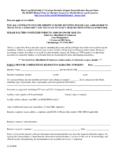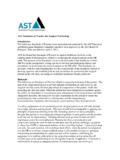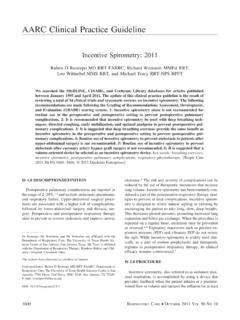Transcription of Nutrition Support in the Bariatric Patient: When …
1 May 6, 2015 Presenters:Kellene A. Isom, M S , R D, LDNB ariatric Program Manager and Senior Bariatric DietitianCenter for Metabolic Health and Bariatric surgery - Brigham and Women's Hospital Kris M. Mogensen, MS, RD, LDN, CNSCTeam Leader Dietitian - Brigham and Women's Hospital Moderator:James M. Rippe, MD Leading cardiologist, Founder and Director, Rippe Lifestyle InstituteApproved for 1 CPE (Level 2) by the Commission on Dietetic Registration, credentialing agency for the Academy of Nutrition and Webinar SeriesNutrition Support for the Bariatric surgery Patient: When and Why Nutrition Support is NeededConAgra Foods Science Institute With a mission of:Promoting dietary and related choices affecting wellness by linking evidence-based understanding with practiceWebinar logistics CEUs a linkto obtain your Continuing Education Credit certificate will be emailed and available on this webinar s page at 2 days.
2 A recording of today s webinar, slides, and summary PowerPoint will be available to download as a PDF within 2 daysa t : The presenter will answer questions at the end of this webinar. Please submit questions by using the Chat dialogue box on your computer s Faculty Kellene A. Isom, MS, RD, LDNB ariatric Program Manager and Senior Bariatric DietitianCenter for Metabolic Health and Bariatric SurgeryBrigham and Women's Hospital - Boston, MA Kris M. Mogensen, MS, RD, LDN, CNSCTeam Leader DietitianBrigham and Women's Hospital - Boston, MA Moderator:James M. Rippe, MD Leading cardiologist, Founder and Director, Rippe Lifestyle Institute Learning Objectives Outline the four types of Bariatric surgery and the mechanisms by which they affect nutritional status. List indications for initiation of Nutrition Support therapy in the Bariatric patient and determine appropriate mode of Nutrition Support therapy (enteral vs.)
3 Parenteral Nutrition ). Illustrate Nutrition care considerations necessary when working with Bariatric patients on Nutrition Support therapy. Apply Nutrition Support therapy across the spectrum of care for Bariatric surgery patients and identify resources available to registered dietitian nutritionists working with Bariatric patients on Nutrition Support Webinar SeriesNutrition Support for the Bariatric surgery PatientNutrition Support in the Bariatric Patient: When and Why Nutrition Support is NeededKelleneA. Isom, MS, RD, LDNC enter for Metabolic and Bariatric Brigham and Women s HospitalKris M. Mogensen, MS, RD, LDN, CNSCD epartment of NutritionBrigham and Women s HospitalOutline Bariatric procedures have nutritional concerns Indications for Nutrition Support therapy Nutrition care considerations Application of Nutrition Support therapy (case study)What is Weight Loss surgery ?
4 A group of Bariatric and metabolic surgical operations that impact the physiological regulation of body weight and improve morbidity and mortalityrates. Gastric/Restrictive Restricts total amount of food that can be eaten at one time; no alteration of food pathway Laparoscopic gastric banding Combination Gastric manipulation Neural/hormonal changes Roux-en-Y gastric bypass (RYGB) Sleeve gastrectomy (SG) Malabsorptive Malabsorbtion of calories and micronutrients Biliopancreatic Diversion (BPD) w/ or w/o Duodenal Switch (BPD/DS)Types of Bariatric /Metabolic ProceduresSummary of MechanismsMechanismLAGBLSGRYGBBPDG astric restriction++++Modulationof GI hormones-+++MacronutrientMalabsorption-- -+MicronutrientMalabsorption-+++% ExcessWeight Loss40-45%50-60%60-70%60-80%Post-operati ve Micronutrient SupplementationLower RiskHigher RiskAltered Absorption of MicronutrientsVitamin/Mineral Lab MonitoringBPD/DSRYGBSGLAGBC alciumBone Density* IronFe panel, Ferritin, TIBC Vitamin B12 Vitamin B12, MMA FolateRBC Folate ThiaminSerum Thiamin Vitamin D**25-OH-Vitamin D&Serum PTH ZincSerum or Plasma Zinc CopperSerum Copper and Ceruloplasmin Vitamin A, E, and KPlasma Retinol, Plasma Alpha Tocopherol, and Prothrombin Time (PT) *In peri-or post-menopausal women **Often low in obese patients and should be assessed and repleted prior to surgeryAartset al.
5 Obes Surg. 2011; Aills, et al. SOARD, 2008; Gehrer, et al. Obes Surg. 2010; Mechanik, et al. SOARD. 2013; Moize, et al. JAND, 2013. Reported Micronutrient Deficiencies in Recipients of Bariatric surgery Data extracted from reports involving Roux-en-Y gastric bypass, adjustable gastric banding, and biliopancreatic diversionNutrient ConcernsAdjustable Gastric BandingVertical Sleeve GastrectomyRoux-en Y Gastric BypassBiliopancreatic Diversion/Duodenal SwitchStandard Vitamin and Mineral Supplementation*SupplementDosage (RYGB, SG, AGB, BPD/DS)Multivitamin with minerals (complete**)100-200% DV Calcium Citrate X 2-3/dayDivided doses 500-600 mg max doseVitamin D1,200-1,500 mg/day (up to 2000 mg/day)1800-2400 mg/day (BPD/DS)400-800 to 3000 IU/dayElemental iron not to be taken with calcium18-27 mg/day elemental (can be provided in MVI)45-60 mg/day menstruating femalesVitamin B12350-500 mcg/day orally/sublingual/nasal (can be provided in MVI)
6 Or 1,000 mcg/month intramuscularlyZincCopper8 to 15 mg/day elemental**1- 2 mg/day elemental**Vitamin AVitamin K10,000 IU/day (BPD/DS)300 mcg/day (BPD/DS)* patients with pre-operative or post-operative biochemical deficiency states are treated beyond these recommendations**Must include B vitamins, folic acid, thiamin, zinc, copper, selenium, ADEK**1 mg copper is recommended for every 8-15 mg elemental zinc Aills, et al. SOARD, 2008; Mechanik, et al. SOARD. 2013 Post-operative DietRYGB/SG/BPD/DSAGBFoodDurationFood DurationStage 1 Clear Liquid: low calorie, low sugar1-2 daysClear Liquid: low calorie, low sugar1 dayStage 2 Full Liquid: Five 8 oz servings of high protein, low sugar beverages2 weeksFull Liquid: Five 8 oz servings of high protein, low sugar beverages2 weeksStage 3 Soft Foods: Advance as tolerated to smooth, soft foods after stage 23 weeks to 4 monthsSoft Foods: Advance as tolerated to smooth, soft foods after stage 22 to 3 weeks Stage 4 Solid Foods: Advance as tolerated after stage 3; healthy eating for lifeLifetime MaintenanceSolid Foods: Advance as tolerated after stage 3.
7 Healthy eating for lifeLifetime MaintenancePost Fill ProtocolEvery 6 weeks post-op3-6 days following FillIndications for Nutrition Support TherapyConsider nutritional Support if any of the following conditions are present: Patient has been without Nutrition for 5-7 days Expected duration of illness > 10 days Patient is malnourishedIs GI output >600 mL/24 hr , massive GI hemorrhage, prolonged ileus or other contraindication to enteral feeding?Initiate EnteralNutritionEnteral feeding not toleratedAdminister Parenteral NutritionInitiate nutritional Support only if tissue perfusion is adequateand electrolytes and acid-base balance are near normalEnteral Feeding To l e ra t e dReassess PN NeedNOYESB righam & Women s Hospital Algorithm for Determining Route of Nutrition SupportTransition to oral diet if/when ablePractical EN Indications Impaired ingestion (can t eat by mouth) Inability to consume adequate oral Nutrition (can t eat enough by mouth) Impaired digestion, absorption, metabolism Severe wasting or depressed growthEnteral Nutrition Indications.
8 Bariatric surgery Focus Inability to take oral Nutrition for 7-10 days 5- 7 days in the ICU Must have functional GI tract Enterocutaneousfistula where the enteral feeding tube can be inserted distal to the fistula Inadequate oral intake to meet metabolic demands Trauma, burn, critical illness Significant malnutritionGeneral PN Indications Intestinal dysfunction Intestinal ischemia Intestinal obstruction Paralytic ileus Severe diarrhea (> 1 liter/day) Severe malabsorption Diffuse peritonitis Intestinal Board of Directors and The Clinical Guidelines Task Force. Guidelines for the use of parenteral and enteral Nutrition in adult and pediatric patients . JPEN 2002 Parenteral Nutrition Indications: Bariatric surgery Focus Inability to take oral or enteral Nutrition for 7-10 days (5-7 days in the ICU) ECF where the where the feeding tube cannot be inserted distal to the fistula Ileus Intestinal obstruction/stricture Intractable vomiting and/or diarrhea Severe GI bleeding Severe malabsorption Severe malnutrition with inability to use the enteral routeAssessment of Nutritional NeedsEnergy Requirements Questions to consider: How far out is your patient from surgery ?
9 What are your goals? Weight loss, maintenance, or gain? Is the patient hypermetabolic(and/or hypercatabolic)? Is the patient in the ICU or on the floor? Do you have access to a metabolic cart to measure your patient s energy expenditure? If not, which equation to use? Clinical Guidelines: Nutrition Support of Hospitalized Adult patients with ObesityChobanet al, JPEN 2013 Guidelines for the Provision and Assessment of Nutrition Support Therapy in the Adult Critically Ill Patient: Society of Critical Care Medicine (SCCM) and American Society for Parenteraland EnteralNutrition ( ).McClaveSA et al. JPEN 2009 Special Considerations for Critically Ill Obese patients Hypocaloric Feeding BMI > 30 kg/m2: 11-14 kcal/kg actual weight, or 22-25 kcal/kg ideal body weight Research done at BWH: BMI 30-50, use 11-14 kcal/kg actual weight BMI > 50, use 22-25 kcal/kg IBW Some recommend a trial of hypocaloric feeding for all obese patients , critically ill or not Remember, indirect calorimetryis best, if you have it available to youMcClaveet al JPEN 2009 Chobanet al JPEN 2013 Mogensen KM et al JPEN EpubApril 20, 2015 Additional Energy Delivery Considerations Consider energy restriction carefully Consider the clinical situation.
10 Ambulatory, non-hypermetabolic Consider providing what you d normally provide if your patient was eating to promote healthy weight loss Other complications may not be appropriate for energy restriction Large wounds Signs of wasting, malnutritionProtein Requirements Various recommendations: ICU setting Class I and II Obesity: at least 2 g/kg IBW Class III Obesity: at least g/kg IBW Non-ICU setting AACE/TOS/ASMBS Guidelines: 60g/day minimum g/kg IBW based on individual clinical situation Guidelines: At least g/kg actual weight or g/kg ideal body weight Monitoring is essential to be sure you are providing enough proteinMcClaveet al JPEN 2009 MechanickJJ et al. SurgObesRelDis2013 Chobanet al JPEN 2013 Fluid Requirements Consider use oral diet recommendations as a starting point: >1500 mL/day Other options: Age 18-50: 1500 mLfor 1st 20 kg +20 mL/kg for each additional kg Age >50: 1500 mLfor the first 20 kg +15 mL/kg for each additional kg Age 18-65: 35 mL/kg Age >65: 30 mL/kg 1500 mL/m2(need to calculate body surface area) 1 mL/kcalUnanswered question:Which weight to use for weight-based calculations?







